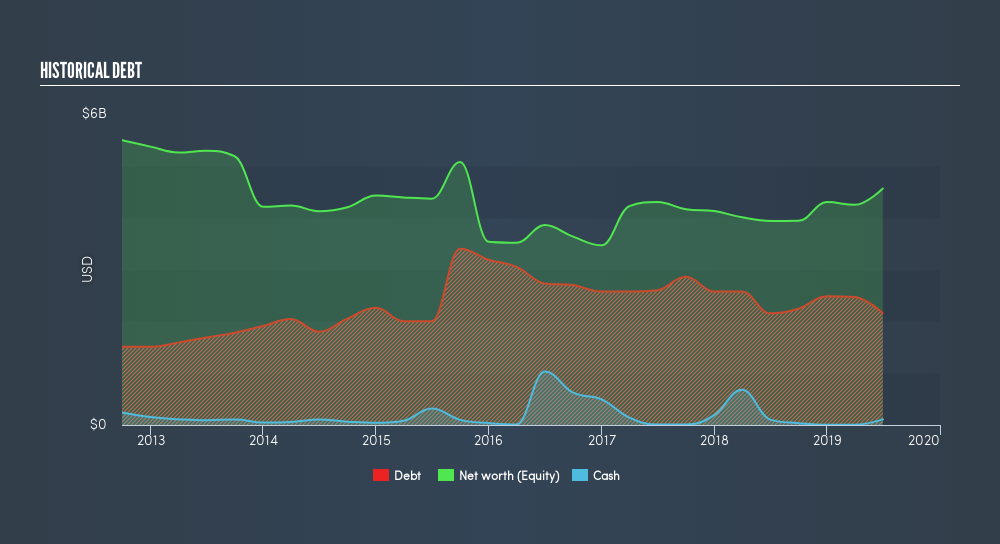
The external fund manager backed by Berkshire Hathaway's Charlie Munger, Li Lu, makes no bones about it when he says 'The biggest investment risk is not the volatility of prices, but whether you will suffer a permanent loss of capital.' So it might be obvious that you need to consider debt, when you think about how risky any given stock is, because too much debt can sink a company. We can see that WPX Energy, Inc. (NYSE:WPX) does use debt in its business. But should shareholders be worried about its use of debt?
What Risk Does Debt Bring?
Debt is a tool to help businesses grow, but if a business is incapable of paying off its lenders, then it exists at their mercy. Part and parcel of capitalism is the process of 'creative destruction' where failed businesses are mercilessly liquidated by their bankers. However, a more usual (but still expensive) situation is where a company must dilute shareholders at a cheap share price simply to get debt under control. Of course, the upside of debt is that it often represents cheap capital, especially when it replaces dilution in a company with the ability to reinvest at high rates of return. When we think about a company's use of debt, we first look at cash and debt together.
View our latest analysis for WPX Energy
What Is WPX Energy's Net Debt?
As you can see below, WPX Energy had US$2.16b of debt, at June 2019, which is about the same the year before. You can click the chart for greater detail. On the flip side, it has US$109.0m in cash leading to net debt of about US$2.05b.

How Strong Is WPX Energy's Balance Sheet?
Zooming in on the latest balance sheet data, we can see that WPX Energy had liabilities of US$1.03b due within 12 months and liabilities of US$2.97b due beyond that. Offsetting these obligations, it had cash of US$109.0m as well as receivables valued at US$505.0m due within 12 months. So its liabilities outweigh the sum of its cash and (near-term) receivables by US$3.38b.
This deficit is considerable relative to its market capitalization of US$4.34b, so it does suggest shareholders should keep an eye on WPX Energy's use of debt. Should its lenders demand that it shore up the balance sheet, shareholders would likely face severe dilution.
We measure a company's debt load relative to its earnings power by looking at its net debt divided by its earnings before interest, tax, depreciation, and amortization (EBITDA) and by calculating how easily its earnings before interest and tax (EBIT) cover its interest expense (interest cover). The advantage of this approach is that we take into account both the absolute quantum of debt (with net debt to EBITDA) and the actual interest expenses associated with that debt (with its interest cover ratio).
While WPX Energy's low debt to EBITDA ratio of 1.4 suggests only modest use of debt, the fact that EBIT only covered the interest expense by 3.7 last year does give us pause. But the interest payments are certainly sufficient to have us thinking about how affordable its debt is. We also note that WPX Energy improved its EBIT from a last year's loss to a positive US$580m. When analysing debt levels, the balance sheet is the obvious place to start. But it is future earnings, more than anything, that will determine WPX Energy's ability to maintain a healthy balance sheet going forward. So if you want to see what the professionals think, you might find this free report on analyst profit forecasts to be interesting.
Finally, while the tax-man may adore accounting profits, lenders only accept cold hard cash. So it is important to check how much of its earnings before interest and tax (EBIT) converts to actual free cash flow. During the last year, WPX Energy burned a lot of cash. While investors are no doubt expecting a reversal of that situation in due course, it clearly does mean its use of debt is more risky.
Our View
Mulling over WPX Energy's attempt at converting EBIT to free cash flow, we're certainly not enthusiastic. But at least its net debt to EBITDA is not so bad. Overall, we think it's fair to say that WPX Energy has enough debt that there are some real risks around the balance sheet. If everything goes well that may pay off but the downside of this debt is a greater risk of permanent losses. Above most other metrics, we think its important to track how fast earnings per share is growing, if at all. If you've also come to that realization, you're in luck, because today you can view this interactive graph of WPX Energy's earnings per share history for free.
At the end of the day, it's often better to focus on companies that are free from net debt. You can access our special list of such companies (all with a track record of profit growth). It's free.
We aim to bring you long-term focused research analysis driven by fundamental data. Note that our analysis may not factor in the latest price-sensitive company announcements or qualitative material.
If you spot an error that warrants correction, please contact the editor at editorial-team@simplywallst.com. This article by Simply Wall St is general in nature. It does not constitute a recommendation to buy or sell any stock, and does not take account of your objectives, or your financial situation. Simply Wall St has no position in the stocks mentioned. Thank you for reading.
Market Insights
Community Narratives


